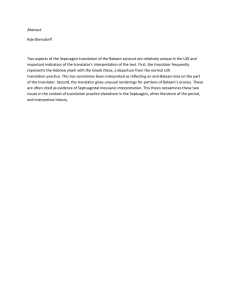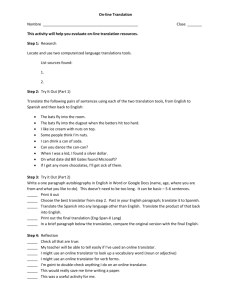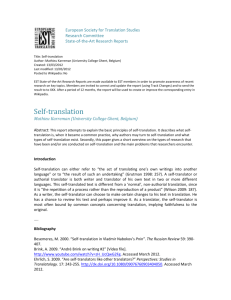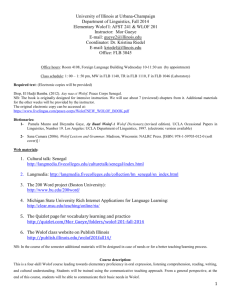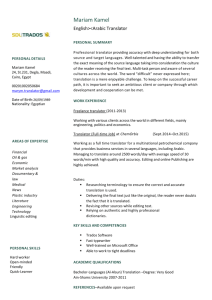The Role of the Native Language in Postcolonial Translation
advertisement
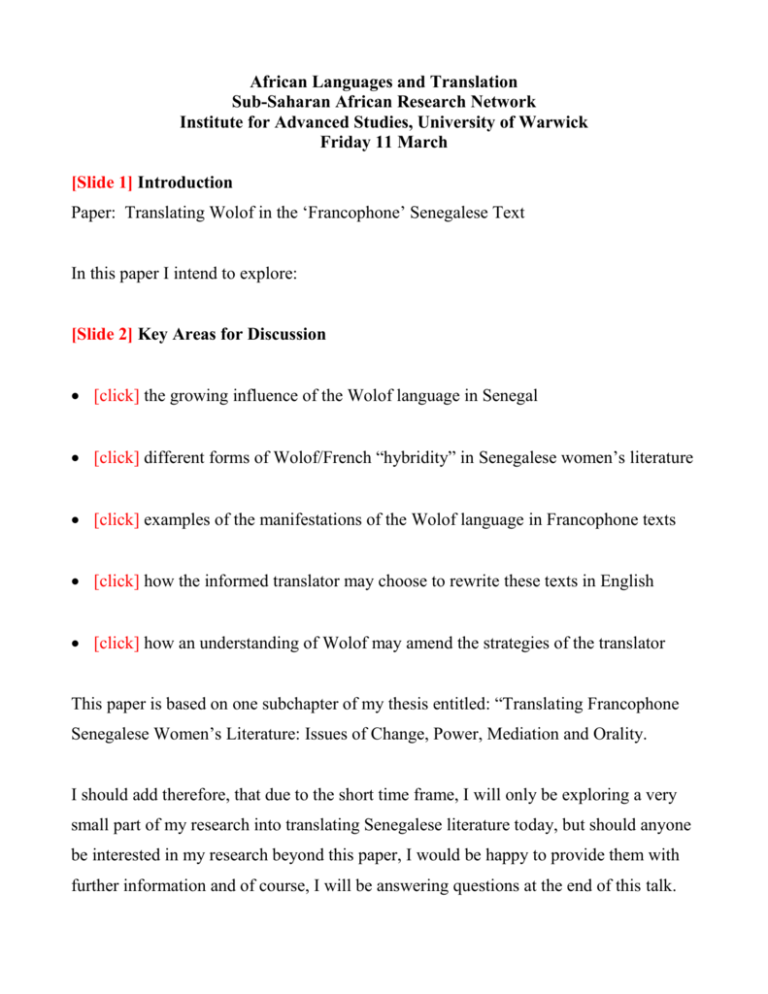
African Languages and Translation Sub-Saharan African Research Network Institute for Advanced Studies, University of Warwick Friday 11 March [Slide 1] Introduction Paper: Translating Wolof in the ‘Francophone’ Senegalese Text In this paper I intend to explore: [Slide 2] Key Areas for Discussion [click] the growing influence of the Wolof language in Senegal [click] different forms of Wolof/French “hybridity” in Senegalese women’s literature [click] examples of the manifestations of the Wolof language in Francophone texts [click] how the informed translator may choose to rewrite these texts in English [click] how an understanding of Wolof may amend the strategies of the translator This paper is based on one subchapter of my thesis entitled: “Translating Francophone Senegalese Women’s Literature: Issues of Change, Power, Mediation and Orality. I should add therefore, that due to the short time frame, I will only be exploring a very small part of my research into translating Senegalese literature today, but should anyone be interested in my research beyond this paper, I would be happy to provide them with further information and of course, I will be answering questions at the end of this talk. In researching the translation of literature by Senegalese women writers, I came across a quote from a paper entitled “The Politics of Translation” by Gayatri Spivak in which she states that: [Slide 3] Learn her mother tongue! “Rather than imagining that women automatically have something identifiable in common, why not say, humbly and practically, my first obligation in understanding solidarity is to learn her mother tongue. You will see immediately what the differences are. You will also feel the solidarity every day as you make the attempt to learn the language in which the other woman learnt to recognize reality at her mother’s knee. This is preparation for the intimacy of cultural translation.” (Politics 379) When translating Francophone texts into English, it is often considered sufficient to understand French and English. However, French is at least the second, and sometimes the third or fourth language of many Senegalese writers, and the local languages that came before it are rarely entirely absent from their works of literature. Here, Spivak is suggesting that an individual learns the native language in order to translate, and I don’t believe this just means translating from a native language into English, but also when translating Francophone texts into English. In other words, that local African languages need to be learnt in order to translate African texts written in European languages. So, by learning local Senegalese languages how can this effort influence the translation process when rewriting in English? To what extent is it a necessity in postcolonial translation? And is it possible to develop translation strategies and theories to accommodate this concept? In most African countries there are a number of widely spoken local languages, but what is unusual about Senegal is that one native African language is spoken by four fifths of the population, and therefore influences most people in the nation, including Francophone writers – that language is Wolof. First defined by Fiona McLaughlin as “wolofisation” (153), the growing influence of the Wolof language is portrayed by Françoise Lionnet as dominating Francophone literature because “French is appropriated, made into a vehicle for expressing a hybrid, heteroglot universe.” She describes it as a “kind of “linguistic métissage” (326) which Maweja Mbaya notes in the works of many Francophone writers who: [Slide 4] Wolofisation “...make use, in their work, of words, expressions and grammatical structures that come from local languages and cultures, not because they are unaware of French norms, but through pure realism, and with the view to translating their real daily life. Respecting the standard norm no longer seems to be very important.” (this quote has been translated into English from the French, which is on your handout, point A.) Hence, Wolof is not simply a common tongue that is spoken by users of different languages, but it also has an influence on the other languages that surround it, as well as upon the translator who not only has to mediate between two languages and cultures, but at least three – in the case of the Senegalese writer Mame Seck Mbacké who is of Wolof ethnicity – at least Wolof, French and English – the language the translator is working into in this instance. [Slide 5] Wolofising French But for the translator to form a strategy for dealing with texts that draw from multiple languages such as those by Francophone Senegalese women writers, it is first necessary to define the specific ways in which this type of hybridity may manifest itself within the writer’s works. In fact, Yves Clavaron speaks of two kinds of hybridity – that of genre (which I won’t have time to deal with today) and that of language, which will be discussed here. Both overt linguistic hybridity (switching between two languages) and discreet linguistic hybridity (one language or its structures, grammar and idioms articulated in another), have been discussed at length by theorists and can be broken down into separate categories for the purpose of this study. For example, in The Empire Writes Back, Ashcroft et al. speak of [click] “selective lexical fidelity,” leaving untranslated words from a local language in the text to highlight cultural distinctiveness (37). And in Senegalese terms, Mbaya underlines the ways in which the French and Wolof languages interact to produce a hybrid form of communication. He describes [click] “code-switching” within conversations; beginning a discussion in Wolof, and switching to French half way through. This type of “code-switching” is also employed regularly by television presenters, for example (91). It is parallel to Ashcroft et al’s “selective lexical fidelity,” but is distinct in that “code switching” is where one language is spoken then swapped to another, whereas “selective lexical fidelity” usually describes the way in which the French language is punctuated by the odd word in a local language. An extreme form of code-switching is described by Mbaya as a dialect called [click] “le français sénégalais,” (“Senegalese French”) or “le français langue d’Afrique,” “The French language of Africa” or “Africa’s French language.” a total mélange of the two languages (171) and used on the streets of Senegal. Mbaya cites the following example: [Slide 6] Le Français Sénégalais “Stabilité politique su amul, économie bi du muna dox” (121), which is literally: [click] “Political stability if there is none, the economy will not work,” meaning: [click] “If there is no political stability, the economy will not be good.” [Slide 7] Wolofising French Then there is discreet linguistic hybridity, which firstly can be found in the form of [click] ‘semantic hybridity’ in the way that words function, their value and meaning, which has been discussed by theorists such as Homi Bhabha (Location 248) or Kwaku Gyasi, who describes semantic shifts whereby European words and phrases are assigned new meanings (African 151). Mbaya too cites the creation of entirely new words for phrases that are far more accessible in Wolof, but are based around the French language. For example, “absenter quelqu’un” means “not to be able to find someone because of their absence.” This does not exist in standard French, but it sounds French (161). This can also be considered a form of “calquing” (Makouta-Mboukou, Introduction). Finally, Mbaya reveals evidence of grammatical influences of Wolof upon the French language, where a French adjective such as “normal” is transferred into the negative form using a Wolof construct – “normal” becomes “normalul,” meaning ‘it isn’t normal’ (121). This can be described as [click] ‘syntactic and grammatical hybridity,’ a type of relexification, which uses structures or grammar from one language and expresses them in another. These different forms of linguistic hybridity can be found in Senegalese women’s works. Firstly, “code switching” was found to be particularly evident in Mame Seck Mbacké’s poetry collection entitled Pluie-poésie: Les pieds sur la mer where she places a poem entitled “Timis” written in Wolof (33) half-way through the book – this is on your handout, point B, with a translation into English. The rest of the poems are written almost entirely in French. The use of the Wolof language and the unusual layout of the poetry mean the text type is unclear. Is this Western-style poetry or oral poetry more reminiscent of African tradition? By translating the poem literally at first, the text type is clearer, individual phrases can be understood, and the translator can decide how to lay out the poem in translation. In fact, although the poem does use repetition, some rhyme and a clear rhythm, it generally follows a Western style. Either way, the translator can make an informed decision in rewriting the text. Furthermore, if the translator chooses to rewrite the entire collection and she understands a few words of Wolof, she would know there is probably no need to translate this poem at all, for a version does appear in French on the next page. The translator’s decision then would be whether or not to translate the French version or the Wolof one for an English collection, for example. Having lived in Senegal and experienced the source text culture and language was an immense help with the translation of some of the sentences, but it also raised questions that lack of knowledge would not have. This is evident in the analysis of the following extract from Le froid et le piment, also by Seck Mbacké, where the use of “selective lexical fidelity” is apparent: [Slide 8] Example: Selective Lexical Fidelity Le long des trottoirs, sous le froid mordant et dans la neige, traînent des sabadors, des boubous en flammes jetés par les fenêtres.... (Seck Mbacké 41) Along the pavement, in the snow and biting cold, there is a trail of sabadors, flaming boubous which have been thrown from the windows.... “Boubou” is known by many Europeans as an item of clothing worn in West Africa, but the word “sabador” is an outfit worn by men in Senegal, consisting of trousers and a smart type of “boubou” worn as a shirt. Whilst it looks in this sentence that the latter is explaining the former, the words in fact have different meanings. Only the lack of “and” implies that Seck Mbacké is providing an explanation. In some ways, the above translation is not completely satisfying, but not wanting to over-domesticate the English version, that part of the sentence has been translated almost word for word. [Slide 9] Wolofising French In other examples, a Wolof word or phrase is followed by a translation into French in brackets. Chantal Zabus describes this technique of tagging or explaining an African word or phrase with its Europhone equivalent as [click] “cushioning” (158-159). For example: and this is on your handout, point C: “Elle a même préparé du thiébou dieune (riz au poisson) à ce dernier” (Seck Mbacké, Froid 63). Whilst “riz au poisson” by no means describes the dish, again there has been an attempt to avoid over-domestication. However, the transcription of thiébou dieune is better amended: “She even made ceebu jën (fish and rice) for him.” In this transcription, the modern standardised version prescribed by the Centre de Linguistique Appliquée de Dakar (Malherbe 25) has been used, so it can be pronounced correctly by the well-informed. Seck Mbacké’s transcription is too firmly embedded in the French language. “Cushioning” as a form of “selective lexical fidelity” is not only present in Seck Mbacké’s poetry and prose, but also her play entitled Qui est ma femme? where conversations between two of the protagonists combine both Wolof and French. The following example is on your handout, point D: ADAMA: Amaïa. Arrête; Amaïa écoute-moi. Tu sais que ton mari t’a passé tous les caprices. Alors! De grâce reprends-toi. Adina amoul solo. La vie est si éphémère. AMAIA: Si tu as des conseils à donner adresse-toi à ta femme. Toppatol sa affaire. Occupe-toi de tes oignons. Tu est pire que l’assassin qui vient présenter ses condoléances. (104) ADAMA: Amaïa. Stop; Amaïa, listen to me. You know your husband has indulged all your whims. Come on! For goodness sake, pull yourself together. The world / life is not important. Life is too short. AMAIA: If you have advice to give, speak to your wife. Mind your own business. Mind your own business. You are worse than a murderer offering his condolences. Understanding the native language of Wolof, it can be seen that Seck Mbacké has translated each of the Wolof phrases into French in the next sentence. Evidently, this means that the Wolof phrases sound ‘silly’ when translated into English, and more suitable to be left untranslated so there is no unnecessary repetition in the English language. However, this does not necessarily have to be the case. The domesticating translator may decide to remove evidence of the Wolof language, or footnote the Wolof. Alternatively, the Wolof of Senegal could be translated into the Wolof of the Gambia, so for instance, “Adina” could become “Aaduna,” “amoul” changes to “amut” and “solo” to “soloh.” Again, the translator is mirroring the source text writer by working interlingually between a native language and a colonising language: ADAMA: Amaïa. Stop; Amaïa, listen to me. You know your husband has indulged all your whims. Come on! For goodness sake, pull yourself together. Aaduna amut soloh. Life is too short. Seck Mbacké’s extract also contains a more subtle deviation from standard grammar where “Tu est” spelt E S T has been written as opposed to “Tu es,” spelt E S. As this is a play and the deviation would not be highlighted orally, the translator may decide to leave this be and translate as “You are,” a decision supported by the fact that this deviation is an anomaly. Alternatively, the translator may decide to highlight the glitch and translate as “You is,” encouraged by the fact that this is indeed what was printed in the ‘original’ text. Chantal Zabus also describes a common technique in Europhone African literature of “contextualisation,” [click] where meaning of a word in an African language is implied by the words and phrases that give it immediate context (158). This is not as common in Francophone Senegalese women’s literature as cushioning, but can be found in the poems of Ndeye Coumba Mbengue Diakhate. For example, two lines of the poem “Le secret du griot” read: “Ce sorcier m’a confié: pleurons frère: Baay Amath, / Dans la nuit s’éteindra. Mon tam-tam, sur la natte...” Whilst the term “tam-tam” is well-known to many readers of African literature as a type of drum, the Wolof word and name “Baay Amath,” meaning “father Amath” are not. However, their meaning is somewhat implied throughout the poem. Each verse has the same structure, clearly mentioning a different family member or individual at the end of the same verse line. Whilst the reader may not know definitively what “baay” means, the context provides the reader with the necessary basic understanding. Mbengue Diakhate clearly chooses this method of embedding the Wolof language in the French text. The translator must decide whether to do the same in the English translation, which would be the preferable solution (note that “baay” also means “father” in Gambian Wolof), or to translate the term into English within the text, or even to footnote the term. With regard to “semantic hybridity,” a number of examples both of Wolof and Arabic punctuating the French language can be found in Seck Mbacké’s text, Le froid et le piment. One of the most interesting is found in the following sentence: [Slide 10] Example: Semantic hybridity La poignée de mains traditionnelle et symbolique et les salutations en longueur, les salamalecs ne manquèrent pas avec des nouvelles sur la santé des vieux amis. (93) Here, the meaning of the word “salamalecs” is an issue. This clearly comes from Salamaalekum, taken from Arabic “peace be upon you,” but used as an initial greeting to say hello. In the Collins Robert dictionary, this is translated as “bowing and scraping,” and online it has similar pejorative translations. From a detailed reading of the text, it appears that Seck Mbacké does not wish to be critical in this instance, so the translator has two options – to replace the word “salamalecs” with “Salamaalekum” or find an alternative term which is more familiar to Anglophone readers. Here, the translator may also be assisted by the fact that there are many writers from the Asian community writing in English who may already have familiarised the Anglophone reader with common Islamic terms, including forms of greeting, and therefore to use “Salamaalekum” would be acceptable. Nevertheless, this translation does not seem to work in this context for it sounds awkward in English. Instead, in a more fluent translation, the word “greetings” has been employed, and the translation for salutations has been switched to “hellos:” [click] The traditional, symbolic handshake and lengthy hellos, the greetings weren’t lacking in news about old friends and their health. Kiné Kirama Fall wolofises her works through “semantic hybridity,” and to understand this, it is necessary to refer to a common Wolof introductory conversation: [Slide 11] Example: Common Wolof Introduction Na nga def? Maa ngi fi rekk. Sa yaram jàmm? Jàmm rekk. Literally: How are you doing? I am only here. Your body peace? Only peace. Meaning: How are you? I am fine. Are you well? Very well. In her poem, “Toi qui t’en vas, ” Kirama Fall writes the lines, “Que la paix soit dans son cœur / La paix seulement” (Élans, 29). The phrase “Only peace” is not a phrase used commonly in French or English, but it is recreated by Kirama Fall. Had the translator not studied Wolof (and its link to Arabic), the depth of this phrase would not be recognised. Potentially, it could be translated incorrectly, perhaps by overdomestication of the wolofised language, but it also offers the translator the opportunity to choose whether she wishes to explain this to the target text reader. By translating the culture around her into writing, Kirama Fall works both within her languages (intralingual translation), and between languages (interlingual translation), creating a French phrase from the native tongue – “Only peace.” The translator who has studied Wolof to a small degree will recognise this phrase and will be able to make an informed decision as to how this should be translated; either literally from the French, or otherwise, or even adding a footnote to explain the commonness of the words and their link to well-being. In this way, the translator is mirroring the behaviour of the source text writer, by working interlingually between French, Wolof and English, and intralingually in finding a suitable solution to explain the phrase in translation. Returning to Le froid et le piment by Seck Mbacké, there are far fewer examples of syntactical or grammatical hybridity, but there are some very subtle signs of Senegalese influence on the French language. In a book on Senegalese writer, Sow Fall, postcolonial theorist Trinh T. Minh-ha comments on the way Sow Fall speaks a Senegalised French which she describes as containing deliberate repetitions of clichéd phrases and playing on stereotypes in certain dialogues (69). And in the dialogue of Le froid et le piment you see similar effects, for example: [Slide 12] Deliberate repetition of clichéd phrases Des conneries! Des conneries! Je vais en dire. Je vais en dire parce que j’en ai trop vues. J’en ai trop vues de toutes les couleurs. (Seck Mbacké 85) Bullshit! Bullshit! That’s what I say. That’s what I say because I’ve seen too much of it. I’ve seen too much of it, in every shape and form. The important task for the translator working semantically is to recognise these stylistic effects and attempt to retain them in translation, which has been accomplished in this version. Further, grammatically, one of the noticeable features of Wolof is its lack of prepositions (Malherbe 35) [Slide 13] Wolofising French and this sometimes appears to affect the writing of Francophone texts. In a poem by Seck Mbacké from her book, Les alizés de la souffrance, not only is there a lack of prepositions, but also a lack of variety. This may be deliberate or involuntary, but it is certainly a feature of the text and should be considered during textual analysis pretranslation. Finally, an additional form of hybridity can be noted where the French [click] imitates the sounds of the Wolof language. The following extract from a poem entitled “Ce Soir” by Ndiaye Sow exemplifies this: [Slide 14] Imitating the Sound of Wolof L’horizon est vêtu De pourpre et d’or Et se mire dans la mer Pour parfaire ses plis. Spectacle grandiose À nul autre pareil, Offert chaque soir Par l’ARTISTE éternel. (31) The Wolof language uses many plosive and nasal consonants, which is in part due to their unusual classification system, which consists of eight words for ‘the,’ in the singular - ‘bi, gi, ji, ki, li, mi and si’ (Malherbe 29), and also because Wolof nasalises certain letters, those often transcribed as mb, mp, nd, nk, for example. Finally, the language simply does rely more on strong, definite sounds than either French or English. Hence, in translation, it is considered a priority to replicate some of these sounds in the target text: The horizon is clothed In crimson and gold And is mirrored in the sea Perfecting its pleats. A magnificent show Unparalleled, Presented each evening By the eternal ARTIST. Some translation scholars may argue that these are simply forms of alliteration and will be recognised anyway by a good translator. Nevertheless, for a semantic translation, there needs to be a recognition not just of the alliteration, but of the type of alliteration. In the translation here, the presence of most of the key plosive and nasal consonants that reflect Wolof have been imitated. Only in this way can a translator balance both meaning and aesthetics. Interestingly, In their analysis of translation between French and English, Vinay and Darbelnet list seven different translation methodologies: “borrowing,” “calque,” “literal translation,” “transposition,” and “modulation,” “equivalence” and “adaptation”(definitions of which can be found on your handout), thereby providing an excellent summary of the ways in which an individual may cope with the varying challenges of literary translation. The examples analysed here use each of these methods. However, I believe that a thorough knowledge of the native language may alter which methodology is used. Understanding, for example, that a word mimics the sound of Wolof may alter a translator’s perspective, so instead of using a literal translation, an equivalent term may instead be used in order to represent both sound and meaning at the same time. The number of methodologies has not changed, but the way in which they are used has been adapted to suit the dimensions of hybrid texts such as those written by Francophone Senegalese women writers. [Slide 15] Conclusions So in conclusion, [click] the ways in which Senegalese women authors hybridise their texts through the use of Wolof varies greatly from writer to writer and clearly not everything written in Francophone Senegalese women’s works is an issue in translation. [click] But unless a translator is aware of both Wolof and French and of the full cultural context of a piece of work, how can she be sure she is not missing something? How can she be certain that she is aware of the full range of interpretations of the source text? Kwaku Gyasi talks of an aggression in relation to the writing of Francophone African texts by describing a “violence” used by authors against the colonial language, distorting the European language to extremes to better represent their native African tongue. But experience so far of Senegalese women writers is that they are generally more subtle than that. [click] Their action could be described as “clever manipulation” rather than “violence.” And this subtlety is harder to spot than a more aggressive treatment of a text. [click] In my thesis, I went beyond this initial discussion of wolofisation to talk about issues of untranslatability of language that is very firmly embedded in the Wolof culture and for which we have no direct translation in English. [click] I now hope to expand my research further as part of a postdoctoral project, analysing a wider range of local languages such as Pular, Mandinke or Soninke and the way in which they have been translated in Francophone Senegalese poetry and then into the English language. [Slide 16] Questions and comments

